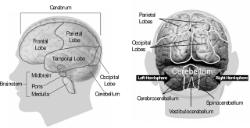 Are you a creative person?
Are you a creative person?
If you answered yes to this question, feel free to skip ahead a few paragraphs. If you answered no, we need to have a talk.
The reason many people find it difficult to come up with content ideas is they have bought into the myth of creativity – that some people have it and some people don’t. Here are two important things to understand:
- You are not a left-brained or a right-brained person.
- You have just as much natural creativity as Albert Einstein, Steve Jobs, and Bill Gates.
The common myth of right and left-brain thinkers comes from a 1960s split-brain study involving patients who had the corpus callosum, the bundle of fibers connecting their hemispheres, cut as a treatment for epilepsy.
For healthy individuals, the right and left hemispheres are intimately connected. What’s more, they are both required for creative thought and idea generation.
Researcher Graham Wallis studied the quadrants of the brain required for generating creative ideas and found that all four quadrants are activated at some point in the process.
So if idea generation isn’t a matter of natural creativity, where do ideas come from? What most “creative” people understand is that coming up with ideas is a process, just like creating anything else. According to James Webb Young, author of A Technique for Producing Ideas:
“… the production of ideas, too, runs on an assembly line; that in this production, the mind follows an operative technique which can be learned and controlled; and that its effective use is just as much a matter of practice in the technique as is the effective use of any tool.”
What does this process look like?
Luckily there is a lot of research surrounding the idea-generation process, all with their own accompanying idea-generation models. At some point, it comes down to your own personal preference. Let’s quickly take a look at three popular idea-generation processes and then pick out some common trends that you can use to improve your ideation immediately:
IR3 Idea Generation Process Model
Researchers at the University of Illinois performed a study of the idea generation techniques among creative professionals to come up with their Design Cycle. The Design Cycle consists of three stages: Idea Generation, Implementation, and Evaluation. Within the Idea Generation stage are three non-distinct categories which use as many cycles as necessary to gain real inspiration:
- Research – Identify the problem and collect the resources needed to solve it.
- Represent – Sketch ideas, create models, and actively test out ideas.
- Refine – Evaluate the representations and make improvements.
Borrowing Brilliance
In his book, Borrowing Brilliance: The Six Steps to Business Innovation by Building on the Ideas of Others, David Kord Murray outlines a six-step process for idea generation based on his experience as a Chief Innovation Officer:
- Defining-Define the problem you’re trying to solve.
- Borrowing-Borrow ideas from places with a similar problem.
- Combining-Connect and combine these borrowed ideas.
- Incubating-Allow the combinations to incubate into a solution.
- Judging-Identify the strength and weaknesses of the solution.
- Enhancing-Eliminate weak points while enhancing strong ones.
A Technique for Producing Ideas
Finally, we come back to James Webb Young, who I mentioned before. In his book, he describes his idea generation process as simple but continues by saying, “while simple to state, it actually requires the hardest kind of intellectual work to follow so that not all who accept it use it.”
- Gather Raw Materials – Perform research to gain specific and general resources.
- The Mental Digestive Process – Work with the raw material you have collected and look for relationships.
- Unconsciously Process – Drop the subject and let your subconscious work.
- A-Ha – Out of nowhere, the idea will appear.
- The Final Stage – Work with your idea to evaluate and improve it.
The Key Elements of Idea Generation
Do you really need three different models for generating ideas just to fill your content calendar? Probably not, but understanding the various research surrounding idea generation should help you see some very clear commonalities. The process is simple, and whatever route you take, there are very clear and important elements you should include. Here are the ones that stand out to me:
Research and Borrow
People known for creating a lot of brilliant ideas understand that ideas have to come from somewhere. You aren’t going to be struck by lightning and, all of a sudden, see a clear image of this month’s whitepaper’s cover page. You need to research your industry, competitors, keywords, buyer personas, content analytics, and anything else you can add as the raw materials you’ll need to generate fresh ideas.
One of the so-called creative geniuses I mentioned in the intro, Steve Jobs, said:
“Creativity is just connecting things. When you ask creative people how they did something, they feel a little guilty because they didn’t really do it. They just saw something. It seemed obvious to them after a while.”
Represent/Combine/Digest
Whatever their word for it, all of the researchers identified a key point in the idea generation process where you need to work with your ideas to allow them to fully form. This is where a team brainstorming meeting can come into play. Experiment with your ideas, make new connections, force relationships, question assumptions, and perform other techniques to see your information in a new way.
The Power of the Subconscious
Even the fictional creative genius, Don Draper, had a process. “Just think about it deeply, and then forget it. An idea will…jump up in your face.”
Harvard researchers have found that distracting yourself from the idea-generation process can help you disengage from a fixation on an ineffective solution. The longer you work on an idea, the more entrenched you’ll become in a single way of thinking. That’s what creates 20 blogs on the same topic with no new or interesting insights. Step away from the problem, go for a run, sleep on it, and you’ll give your subconscious a chance to form new connections and new ideas.
Evaluate
Another thing all of these models have in common is the final stage of evaluation. Creating ideas is a difficult process. Once you are 95% of the way there, resist the urge to call it good enough. After you have your raw concepts for content ideas, evaluate them and how they fit into your overall content creation strategy.
Creating a complete content calendar requires plenty of content, but that content is useless if it doesn’t fit your audience, buyers’ journey, keywords, and overall marketing plan.
Hopefully, this article gave you a good basis for forming your own idea-generation process! Maybe one of the three I listed spoke to you, or maybe you’d like to take elements of each. The important thing is to understand that what differentiates good content marketers from bad isn’t creativity but the ability to work through a creative process. Define your idea generation process and get to work!
Need help generating ideas? Create a free company account on nDash, and writers from our community will pitch you unique topics for blogs, articles, whitepapers, and more!
